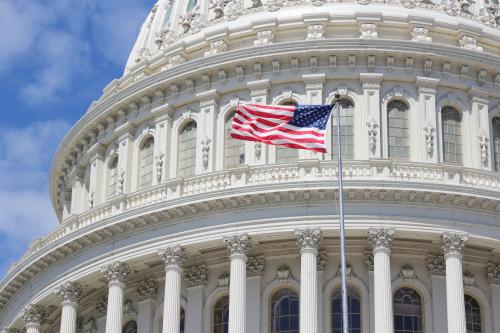Banks can be a source of stability during the economic and financial turbulence caused by COVID-19. Thanks to important regulatory reforms and better risk management since the global financial crisis, banks have much higher capital and liquidity positions than they had in 2007. Their stronger financial position is allowing the banking regulators to encourage banks to use their capital and liquidity buffers to support new lending, and to work with borrowers to modify existing loans.
The Federal Reserve also has reduced the leverage ratio capital requirement (the capital required for total exposures without regard to risk of those exposures) until March 31, 2021, by allowing them to deduct deposits at the Fed and Treasury securities in their portfolios from their measure of exposures. This action releases capital and should promote more liquid trading in Treasury markets, as well as more lending. These steps give banks more flexibility in using the capital they have.
“[B]anks should go further and suspend share repurchases for longer. A longer suspension would lead to a meaningful addition to capital and support continued confidence in the banking system.”
The Fed requested that banks not increase their shareholder payouts (dividends and share repurchases, or buybacks) in response to the temporary relaxation of the leverage capital requirement. In addition, the eight largest banks have already said they would preserve more capital by suspending share repurchases through the second quarter of 2020. But given high uncertainty about economic growth and loan losses, banks should go further and suspend share repurchases for longer. A longer suspension would lead to a meaningful addition to capital and support continued confidence in the banking system. It would be accomplished at a lower cost than a suspension of both buybacks and dividends, and greatly reduce the likelihood that banks would need to make cuts to dividends next year.
Extending the suspension of share repurchases would add substantially to capital. Banking firms lately have been paying out far more in share repurchases than in common-stock dividends. For the eight largest banking firms in 2019, repurchases totaled $100 billion, up from $88 billion in 2018. That’s more than twice the level of dividends on common stock of $36 billion in 2019 and $31 billion in 2018. Combined, repurchases and dividends were about 2 percent of risk-weighted assets for these firms in 2018-19. For the next ten largest domestic banking firms with assets of more than $100 billion, repurchases were $18 billion and dividends were $12 billion. This represents a big change: In 2007, before the global financial crisis, share repurchases were less than half of payouts; in 2018-19, they were two-thirds of total payouts and 1.3 percent of risk-weighted assets.
Since the financial crisis, the Fed has recognized differences between dividends and share repurchases: While both are ways for banks to distribute capital, dividends are set so they can be maintained over most conditions to offer steady income to shareholders, while share repurchases are adjusted frequently as cash flow and investment opportunities fluctuate. As a result, stock prices fall when dividend cuts are announced, because they signal weakness–but not when share repurchases are scaled back, because that may suggest a better use for earnings. The stress tests for many years imposed a soft limit of 30 percent on dividends as share of total payouts so that banks could substantially reduce payouts to shareholders when needed without having to cut dividends.
Some have called for the Fed to require all banks to cut dividends, as authorities in some other countries have done. The Fed probably could justify this given the uncertain economic and financial effects of the pandemic, but it has not taken actions like this before, and it could be misinterpreted as the Fed believing there were significant weaknesses in the banking system. Moreover, the Fed stress tests had prepared for this situation by limiting the dividend share of payouts, and banks can meaningfully add to capital without cutting dividends. Note that in most other countries, share repurchases are not used in the same way or at all, so cutting dividends is the only way to reduce payouts.
Banks subject to the Comprehensive Capital Analysis and Review (CCAR) stress tests submitted capital plans to the Fed on April 6. The Fed will be reviewing these plans to judge how banks are managing capital in this crisis. We don’t know what is in the capital plans or how the Fed will review them. It appears unlikely that banks are proposing to cut dividends in the next four quarters, given they believe they have buffers for a very severe recession, and dividend cuts are costly.
“While stress tests are the best metric that we have of capital sufficiency in the event of a recession, they are inadequate for the current situation…”
Banks should collectively agree now to suspend share repurchases for at least as long as the leverage ratio is eased. They should not wait until the Fed’s annual stress tests are completed in June, and for a request by the Fed which could risk sending a signal of weakness. While stress tests are the best metric that we have of capital sufficiency in the event of a recession, they are inadequate for the current situation for four reasons.
First, while the stress test scenario includes a severe macroeconomic scenario, it did not envision a global pandemic. The scenario assumes the unemployment rate will peak at 10 percent, while some projections for the actual rate are double that. One offset, though, is that current fiscal efforts could reduce the length of the recession relative to the scenario’s assumptions.
Second, current stress tests in the U.S. do not incorporate explicitly any feedback loops between a weakened banking sector and the macroeconomy. This is a shortcoming of the stress tests–in the U.S. and elsewhere–but it is especially important now, where the possibility of an adverse feedback loop cannot be ruled out.
Third, bank balance sheets are growing sharply. Corporate drawdowns on credit lines reportedly have risen by almost $200 billion already, and commercial and industrial (C&I) loans rose $365 billion in mid-March. Bank assets are expected to increase more as consumers draw on credit card lines and trading assets increase. Some private analysts predict assets could increase by more than $1 trillion. But in the stress tests, balance sheets are assumed to remain constant (a nod to simplification, despite the empirical evidence that corporations draw down lines in every recession). With assumed zero growth in balance sheets, there is zero additional required capital for these additional assets in the stress tests.
Fourth, this year the new stress capital buffer (SCB) is being used to establish the capital requirements, and the new SCB likely will lead to a reduction in required capital relative to last year. The SCB rules were issued in early March. The changes are significant, but did not get much attention as the dangers of the virus were becoming more evident. The intention of the SCB is to simplify multiple capital requirements by improving consistency between the regulatory capital requirements and supervisory stress tests. But under the SCB, banks would not be required to hold capital in anticipation of paying out share repurchases and dividends for nine quarters, as they have in the past. Instead, they are required to include only four quarters of dividends, but also the global systemically important banks (G-SIB) capital buffer.
In a dissent, Fed Governor Lael Brainard estimated that the change based on 2019 data would indicate a decline in required Tier 1 capital of $100 billion for the largest banking organizations, of which $40 billion is at the G-SIBs. In contrast, estimates provided by Vice Chairman Randall Quarles suggested that the change, based on a through-the-cycle analysis of payouts from 2013 to 2019, would lead to an increase in required Tier 1 capital of $46 billion for the G-SIBs.
These factors suggest that estimated capital requirements from the SCB will not adequately reflect the risks of the current situation, raising questions about how banks will weather the economic fallout of the pandemic and continue to serve their customers. A simple and cost-effective approach would be for banks to announce now that they will suspend their share repurchases past the second quarter of 2020, in order to continue to lend and to remain a source of stability for the economy as regulations are being relaxed.





Commentary
Banks should suspend share repurchases for longer
April 8, 2020